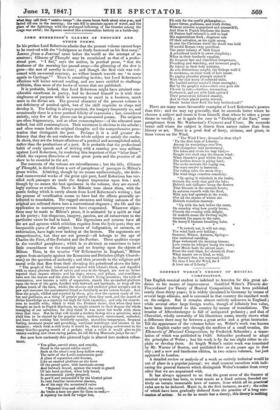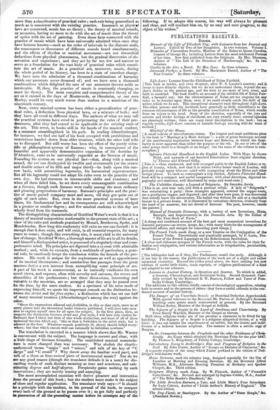GODFREY WEBER'S THEORY OF MUSICAL COMPOSITION.
THE English musical student is indebted to America for this great ad- dition to his means of improvement. Gottfried Weber's Theorie der Tonzeshunst (or Theory of Musical Composition) has been published nearly these thirty years; it is widely circulated in Germany by means of several large editions, and is esteemed in that country the standard work on the subject. But it remains almost entirely unknown in England ; while several other large foreign works, though of infinitely less value, have been introduced to this country by means of translations. The treatise of Albrechtsberger is full of antiquated pedantry ; and that of Cherubini, wholly unworthy of his illustrious name, merely shows what a difference there may be between a great artist and a great instructer. Till the appearance of the volumes before us, Weber's work was known to the English reader only through the medium of a small treatise, the Elements of Musical Composition, by Frederick Schneider ; a trans- lation of which was published in 1829. Schneider professed to adopt the principles of Weber ; but his work is by far too slight either to ex- plain or develop them. At length Weber's entire work was translated by Mr. Warner of Boston, and published five or six years ago in that city ; and a new and handsome edition, in two octavo volumes, has just appeared in London. A detailed review or analysis of a work so entirely technical would be out of place in a popular journal : we shall content ourselves with indi- cating the general features which distinguish Weber's treatise from every other that we are acquainted with. It has always appeared to us that the great error of the framers et' musical systems has been, to treat music as a fixed science, founded ens tirely on certain immutable laws of nature, from which all its practical rules are to be deduced. Music is, in the first instance, an art; the rules of which have been gradually deduced from the practice of a long suc- cession of artiste. In so far as music has a theory, this theory is nothing
more than a classification of practical rules ; each rule being generalized as much as is consistent with the existing practice. Inasmuch as physical laws are concerned, music has no theory ; the theory of musical sounds, or acoustics, having no more to do with the art of music than the theory of optics with the art of painting. Even those facts connected with the practice of music which have been universally admitted when once they have become known—such as the order of intervals in the diatonic scale, the consonance or dissonance of different sounds heard simultaneously, and the effects of rhythm or metrical movement—are not theoretical deductions from physical phtenomena, but the gradual discoveries of ob- servation and experience ; and they are by far too few and narrow to serve as a foundation for the vast body of practical rules which consti- tute the art of music. As a practical art, moreover, music, during the whole period of its history, has been in a state of ceaseless change. We have seen the admission of a thousand combinations of harmony which our ancestors never dreamed of; and we have seen a thousand combinations which delighted the ears of our ancestors thrown aside as intolerable. If, then, the practice of music is constantly changing, so must its theory. The most complete and comprehensive theory of the art as it existed in the days of Monteverde, or Okenheim, or our own Morley, would be very much worse than useless to a musician of the nineteenth century.
Now, every musical system has been either a generalization of prac- tical rules, a deduction from physical laws, or a mixture of both ; and they have all erred in different ways. The authors of what we may call the practical systems have erred in perpetuating the rules of their pre- decessors, after they had ceased to be applicable to the existing state of She art. This error, in books still in the hands of the musical student, is a constant stumblingblock in his path. In reading Albrechtsberger, for instance, we find one half of his book occupied with prohibitions and restrictions handed down from older treatises, which the other half tells us to disregard. But still worse has been the effect of the purely scien- tific or philosophical system of Rameau ; who, in consequence of the beautiful and apparently demonstrative exposition of his doctrine by D'Alembert, came to be universally regarded as the Newton of music. Founding his system on one physical fact—that, along with a musical sound, the ear can distinguish its twelfth and seventeenth (or the octave and double octave of its fifth and major third)—he built upon this nar- row basis, with astonishing ingenuity, his harmonical superstructure. But all his ingenuity could not adapt his rules even to the practice of his own day. He had recourse to innumerable shifts and evasions; and when all these failed him, he set down every unmanageable combination as a licence, though such licences were really among the most ordinary and pleasing progressions of harmony. Rameau's principles and the prac- tice of music parted company more and more, till they got quite out of sight of each other. But, even in the more practical systems of later times, his fundamental law and its consequences are still acknowledged in a greater or smaller 'degree ; and few musical students to this day are wholly freed from his trammels.
The distinguishing characteristic of Gottfried Weber's work is that it is a theory of musical composition conformable to the present state of the art ; a view of the rules and methods practised by Mozart, Beethoven, Spoilt., and Mendelssohn. How tong this conformity will exist no one can foretell : it is enough that it does exist, and will exist, in all essential respects, for many years to come; • though like everything else, it must yield to the universal law of change. Gottfried Weber, a thorough master of his art in all its details, and himself a distinguished artist, is possessed of a singularly clear and com- prehensive mind. His principles are digested into a system with admirable method ; and, while he extracts, from a multitude of particulars, a gene- ral rule, he cautiously keeps the conclusion within the bounds of the pre- mises. His work is unique for the copiousness as well as appositeness of its musical illustrations ; and numberless fine passages from the great masters derive a new interest from exemplifying some principle of art. A part of his work is controversial, as he naturally vindicates his own novel views, and exposes, often with severity and sarcasm, the errors and absurdities of his predecessors ; but these discussions, interesting and valuable to the musician, are so arranged that they may be passed over for the time, by the mere student. As a specimen of his terse mode of expressing himself, we quote his important remark on the distinction be- tween the strict and the free styles ; a distinction which has set one half of many musical treatises (Albrechtsberger's among the rest) against the other.
"Since the expressions alknced and forbidden, in this or that style, meet us at every glance into the theoretical books hitherto published, I will here take occa- sion to explain myself once for all upon the subject. In the first place, then, as respects the distinction between strict and free style, I will here only confess be- forehand that I think but little of this whole distinction, and least of all of those technical theories which say, 'this or that is forbidden in the strict style, but is allowed in the free.' Whatever sounds positively ill, theory should forbid every- where; but that which sounds well can rationally be forbidden nowhere."
The translation is executed in a manner which shows that Mr. Warner is conversant with the subject. The language is correct and clear, with a little tinge of German formality. The established musical nomencla- ture is more changed than was necessary. Why abolish the clearly- understood terms "major " and " minor,' and talk of the key of " C large" and "C small"? Why throw away the familiar word part, and talk of a three or four-voiced piece of instrumental music? Nor do we see any good reason (though the translator defends it in a note) for dis- carding words of such distinct meaning as tone and semitone, and sub- stituting degree and half-degree. Perspicuity gains nothing by such innovations; they are merely teasing and annoying. The most accomplished musician will derive pleasure and instruction from the perusal of this book; but the student must make it the subject of close and regular application. The translator truly says—" It should be a principle with the student, in his perusal of the book, to conquer every inch of the ground as he passes over it ; to get fully and perfectly in possession of all the preceding matter before he attempts any of the
following. If he adopts this course, his way will always be pleasant and clear, and will conduct him on, by an easy and sure progress, to the object of his wishes."



























 Previous page
Previous page